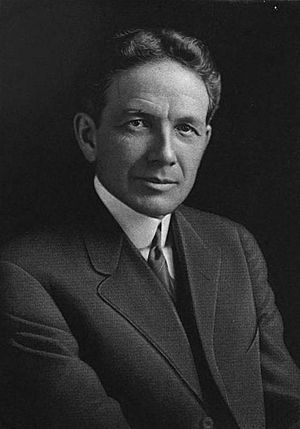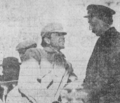William C. Durant facts for kids
Quick facts for kids
William C. Durant
|
|
|---|---|
 |
|
| Born |
William Crapo Durant
December 9, 1861 Boston, Massachusetts, U.S.
|
| Died | March 18, 1947 (aged 85) New York City, U.S.
|
| Occupation | Business |
| Spouse(s) | Clara Miller Pitt (div.) Catherine Lederer (1886–1947) |
| Children | Margery Pitt Durant (1887–1969) Russell Clifford Durant (1890–1937) |
William Crapo Durant (born December 8, 1861 – died March 18, 1947), also known as Billy Durant, was a very important person in the early automobile industry in the United States. He created a new way for car companies to work. He made a system where one big company owned many different car brands. Each brand seemed separate with its own cars, but they were all part of one large company. Durant helped start General Motors with Frederic L. Smith. He also started Chevrolet with Louis Chevrolet. He even founded Frigidaire, which makes refrigerators.
Contents
Who was William Durant?
William Durant was born in Boston, Massachusetts. His family was quite wealthy. William left high school to work in his grandfather's lumberyard. He began his career selling cigars in Flint, Michigan. Later, he started his own company that made carriages.
In 1886, Durant teamed up with Josiah Dallas Dort. They created the Flint Road Cart Company. They started with only $2,000. This company grew into a $2-million business with sales all over the world. By 1890, Durant-Dort Carriage Company was a top maker of horse-drawn vehicles. By the early 1900s, it was the biggest in the U.S.
Durant was not a fan of early automobiles. He thought they smelled bad and were too loud. He even believed they were dangerous. He would not let his own daughter ride in one. Around 1900, many people were upset about how unsafe these new "horseless carriages" were. Durant saw this as a chance to make safer cars. He wanted to create a company that could improve car safety.
To start this big project, Durant decided to buy Buick. Buick was a small car company at the time. It had few sales and a lot of debt. Durant also came up with the idea of modern car dealerships. This is how car companies sell their vehicles through local stores.
How Durant Helped Buick Grow
William Durant was already a millionaire from his carriage company. On November 1, 1904, he took control of the struggling Buick Motor Company. He used his money and manufacturing skills from Durant-Dort to fix Buick. Durant worked hard to promote the Buick name.
Because of his efforts, Buick became the best-selling car in America. It even sold more than older leaders like Ford Motor Company, Cadillac, and Oldsmobile. Even though Buick had no production line and only a few cars ready, they received over 1,100 orders. This happened by the 1905 New York Automobile Show. Durant and Samuel McLaughlin, who was Canada's largest carriage maker, made a deal. They agreed to build Buick engines together for 15 years.
Creating General Motors
Durant used Buick as a starting point for a bigger idea. He wanted to build a huge car company. This company would make several different car brands. It would also own companies that made car parts. This was similar to how his Durant-Dort company worked with carriage building.
On September 16, 1908, Durant and McLaughlin officially started General Motors Holding Company. They also traded a lot of Buick stock for McLaughlin's company stock. This made McLaughlin one of the biggest owners in General Motors. On November 12, 1908, Durant bought Olds Motor Works (Oldsmobile).
In 1908, Durant brought together 13 car companies and 10 parts makers under General Motors. In 1909, GM bought Cadillac and Oakland Motor Car (which later became Pontiac). They also bought many companies that made parts, paint, and other car accessories. By 1910, Durant had bought too many companies too quickly. General Motors faced money problems. Because of this, Durant was forced to leave the company.
Durant's Return to General Motors
But Durant did not give up. In 1911, he supported Louis Chevrolet in starting his own car company, named after Chevrolet. J. Dallas Dort was the vice-president of this new company. In 1913, Dort left Chevrolet. In 1914, Durant sold his share of the Durant-Dort Carriage Company. By 1915, R.S. McLaughlin was building Chevrolet cars. By 1916, Durant used Chevrolet's success to buy enough shares to get back control of General Motors. He led GM again until 1920.
During his time as president (1916–1920), Durant brought the Chevrolet car line into GM in 1919. He also added Fisher Body and Frigidaire. In 1920, he lost control of GM again to other shareholders. He had to pay back $21 million to his friends.
When the U.S. entered World War I in 1917, Durant did not want GM to make things for the war. This caused a disagreement with Henry Leland, the founder of Cadillac. Leland was very patriotic and wanted to help the war effort. Leland left GM and started the Lincoln Motor Co., which made aircraft engines for the war.
While leading Chevrolet, Durant also created other companies, like Republic Motors. This company mainly produced Chevrolet cars. William Durant was honored for his work in 1968. He was inducted into the Automotive Hall of Fame.
How Durant Built United Motors
Durant used his experience from the carriage business. He gathered many companies that made car parts. These included Hyatt Roller Bearing, New Departure Manufacturing, Dayton Engineering Laboratories (later Delco Electronics Corporation), Harrison Radiator Corporation, Remy Electric, Jaxon Steel Products, and Perlman Rim. He put them all into a new company called United Motors Company. He made Alfred P. Sloan from Hyatt Roller Bearing Company its president. In 1918, United Motors was sold to General Motors for $44,065,000. Sloan later became president of GM in the 1920s. He helped make GM the biggest car maker in the world.
Durant Motors: A New Start
In 1921, Durant started a new company called Durant Motors. It began with just one car brand. Within two years, it had several brands. These included the Durant, Star (also called Rugby), Flint, and Eagle. This new company offered as many choices as General Motors. Part of this new business included a factory in Leaside, Ontario, Canada, for making cars.
Just like with General Motors, Durant bought different companies for Durant Motors. Each company made cars for different budgets and tastes. The cheapest car was the Star, which was meant to compete with the Ford Model T. Durant cars were for the middle market. The company was set up very much like GM. They even planned a luxury car called the Princeton, which would compete with Packard and Cadillac. The most luxurious car was the Locomobile.
However, Durant could not repeat his earlier success. The money problems from the Wall Street Crash of 1929 and the Great Depression were too big. His company failed in 1933.
Later Years and Legacy
In the 1920s, Durant became a big investor on Wall Street. On Black Tuesday, which was the day the stock market crashed, he joined wealthy families like the Rockefeller family. They bought many stocks to show people they had faith in the market. But his efforts did not stop the market from falling. By 1936, Durant was bankrupt.
After Durant Motors failed, William Durant and his second wife, Catherine, lived on money given to them by R. S. McLaughlin, and others from General Motors. He then opened a bowling alley and fast-food restaurant in Flint, Michigan. He even worked in the kitchen himself. Durant believed that family entertainment places would be very popular. He hoped to open a chain of 30 bowling alleys.
In 1942, Durant went to Goldfield, Nevada, to open a mine. He hoped the U.S. government would pay him to get minerals for the war. But this idea did not work out. The 80-year-old Durant climbed to the mine entrance to check it. A few days later, he had a stroke that left him partly paralyzed. He and his wife had to move to an apartment in New York City. He spent his last days there.
At the end of World War II, Durant thought there would be a big economic boom. He believed there would be endless possibilities for new products. The last money-making idea he supported before he died was a hair tonic business. Durant's mind was clear until the end. He tried to write his life story, but the stroke made it hard for him to speak clearly. He tried to go back to Flint in 1946, but he was too sick. He became unconscious on March 13, 1947, and died a few days later.
When he died, the Durants had no money left. They had to sell most of their paintings and other valuable things to pay for his medical care. He was buried in a private tomb in Woodlawn Cemetery in The Bronx, New York City. In 1996, he was inducted into the Junior Achievement U.S. Business Hall of Fame.
Durant Park in Lansing, Michigan, is named after him. So is Waterford Durant High School in Waterford, Michigan.
Durant's Castle
In the late 1920s, Durant's son, Russell Clifford (Cliff) Durant, and his third wife, Lea Gapsky Durant, started building a castle. It was their personal home with a private airstrip in Roscommon, Michigan. The huge 54-room mansion mysteriously burned down on February 6, 1931. The Durants never lived in it. Some people thought it was set on fire.
After Lea disappeared in 1934 and Cliff died in 1937, Cliff's fourth wife sold the land. It was bought by George W. Mason, another car executive. When Mason died, he gave the land to the State of Michigan. It is now a nature preserve called the Mason Tract. Only the old foundations of the castle and airstrip remain today. There is a place for canoes and a short history of the castle at the site.
Images for kids
See also
 In Spanish: William Crapo Durant para niños
In Spanish: William Crapo Durant para niños



